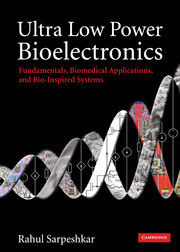Book contents
- Frontmatter
- Contents
- Acknowledgements
- Section I Foundations
- Section II Low-power analog and biomedical circuits
- Section III Low-power RF and energy-harvesting circuits for biomedical systems
- Section IV Biomedical electronic systems
- 19 Ultra-low-power implantable medical electronics
- 20 Ultra-low-power noninvasive medical electronics
- Section V Principles for ultra-low-power analog and digital design
- Section VI Bio-inspired systems
- Section VII Energy sources
- Bibliography
- Index
- Epilogue
- References
19 - Ultra-low-power implantable medical electronics
from Section IV - Biomedical electronic systems
Published online by Cambridge University Press: 02 December 2010
- Frontmatter
- Contents
- Acknowledgements
- Section I Foundations
- Section II Low-power analog and biomedical circuits
- Section III Low-power RF and energy-harvesting circuits for biomedical systems
- Section IV Biomedical electronic systems
- 19 Ultra-low-power implantable medical electronics
- 20 Ultra-low-power noninvasive medical electronics
- Section V Principles for ultra-low-power analog and digital design
- Section VI Bio-inspired systems
- Section VII Energy sources
- Bibliography
- Index
- Epilogue
- References
Summary
When one door of happiness closes another opens; but we often look so long at the closed one that we do not see the one which has opened for us.
Helen KellerImplantable electronics refers to electronics that may be partially or fully implanted inside the body. Several implanted electronic systems today have revolutionized patients' lives. For example, more than 130,000 profoundly deaf people in the world today have a cochlear implant in their inner ear or cochlea that allows them to hear almost normally. Some cochlear-implant subjects have word-error recognition rates in clean speech that are better than those of normal hearing subjects, and they understand telephone speech easily. Cochlear implants electrically stimulate the auditory nerve, the nerve that conducts electrical impulses from the ear to the brain, with an ac current. Cochlear implant subjects are so profoundly deaf that even the feedback-limited ~1000× gain of a hearing aid is not large enough to help them hear. Therefore, an implant that directly stimulates their auditory nerve is necessary. Cochlear implants today are partially implanted systems: the electrodes and a wireless receiver are implanted inside the body while a microphone, processor, and wireless transmitter are placed outside the body.
Patients with Parkinson's disease have had their quality of life significantly improve because of a deep brain stimulator (DBS) that has been fully implanted inside their bodies. This stimulator provides ac electrical current stimulation to a highly specific region in their brain, which is most commonly the subthalamic nucleus (STN).
- Type
- Chapter
- Information
- Ultra Low Power BioelectronicsFundamentals, Biomedical Applications, and Bio-Inspired Systems, pp. 531 - 578Publisher: Cambridge University PressPrint publication year: 2010



